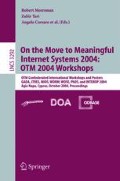Abstract
New forms of cooperation like collaborative business scenarios require a deep but flexible integration of enterprises. To manage cross-organizational business processes existing concepts for business process management need to be adapted and extended. In this paper an architecture is presented, that shows how cross-enterprise processes can be planned, implemented and controlled. The architecture is based on the differentiation of global knowledge within the network and local knowledge of each participating company. Another important part of it is the process lifecycle model that serves as a guideline for the process-oriented setting-up and operation of cooperations. By the use of graphic representations of BPM-models and intuitive metaphor based model-generation and -visualization tools a broad acceptance for the inter-organizational BPM-effort within the network can be achieved.
Access this chapter
Tax calculation will be finalised at checkout
Purchases are for personal use only
Preview
Unable to display preview. Download preview PDF.
References
Scheer, A.-W., Erbach, F., Thomas, O.: E-Business – Wer geht? Wer bleibt? Wer kommt? In: Scheer, A.-W. (ed.) E-Business – Wer geht? Wer bleibt? Wer kommt? 21. Saarbrücker Arbeitstagung 2000 für Industrie, Dienstleistung und Verwaltung, pp. 3–45. Physica-Verlag, Heidelberg (2000)
Naisbitt, J.: Megatrends 1986, 6th edn. Ten New Directions Transforming Our Lives. Warner Books, New York (1986)
Kanter, R.M.: Transcending Business Boundaries: 12,000 World Managers View Change. Harvard Business Review 69(3), 151–164 (1991)
Picot, A., Wigand, R., Reichwald, R.: Information, Organization and Management – Expanding Markets and Corporate Boundaries. Wiley, Chichester
Scheer, A.-W., Grieble, O., Hans, S., Zang, S.: Geschäftsprozessmanagement – The 2nd wave. In: Scheer, A.-W. (ed.): IM Information Management & Consulting 17, Sonderausgabe, 9-15, 10 et seq (2002)
Scheer, A.-W., Grieble, O., Zang, S.: Collaborative Business Management. In: Kersten, W. (ed.): E-Collaboration - Prozessoptimierung in der Wertschöpfungskette. Deutscher Universitäts- Verlag, Wiesbaden, 30 et seq
Scheer, A.-W., Feld, T., Zang, S.: Vitamin C für Unternehmen – Collaborative Business. In: Küting, K., Noack, C. (eds.): Der große BWL-Führer. Die 50 wichtigsten Strategien und Instrumente zur Unternehmensführung. F.A.Z.-Institut, Frankfurt, pp. 123–129, 124 et seq
Linthicum, D.S.: Enterprise Application Integration, 4th edn. Addison-Wesley, Boston (2003)
Liebhart, U.E.: Strategische Kooperationsnetzwerke: Entwicklung, Gestaltung und Steuerung. Dt. Univ.-Verl., Wiesbaden (2002)
zur Muehlen, M., Nickerson, J. V., Stohr, E. A.: Process Integration – From Workflow Models to Web Service Choreography. Istanbul 2003 Euro/Informs (2003), http://www.workflow-research.de/Publications/YVAN.MIZU-ISECON.pdf
Arkin, A.: Business Process Modeling Language. Working Draft
Kotok, A., Webber, D.R.R.: ebXML: The New Global Standard for Doing Business over the Internet. New Riders, Indianapolis (2002)
RosettaNet (Edt.): RosettaNet Implementation Framework: Core Specification, http://xml.coverpages.org/RNIF-Spec020000.pdf
Scheer, A.-W., Beinhauer, M., Habermann, F.: Integrierte E-Prozessmodellierung. Industrie Management 16(3), 19–26 (2000)
Scheer, A.-W.: ARIS – Vom Geschäftsprozess zum Anwendungssystem, 4th edn. Springer, Berlin (2002)
Scheer, A.-W., Borowsky, R.: Supply Chain Management – die Antwort auf neue Logistikanforderungen. In: Kopfer, H., Bierwirth, C. (eds.) Logistik Management – Intelligente I+K Technologien, pp. 3–14. Springer, Heidelberg
Hack, S.: Collaborative Business Scenarios – Wertschöpfung in der Internetökonomie. In: Scheer, A.-W. (ed.) E-Business – Wer geht? Wer bleibt? Wer kommt? 21. Saarbrücker Arbeitstagung für Industrie, Dienstleistung und Verwaltung, pp. 85–100. Physica-Verlag, Heidelberg, 88 et seqq.
Jost, W., Scheer, A.-W.: Geschäftsprozessmanagement: Kernaufgabe einer jeden Unternehmensorganisation. In: Jost, W., Scheer, A.-W. (eds.) ARIS in der Praxis: Gestaltung, Implementierung und Optimierung von Geschäftsprozessen, pp. 33–44, 38. Springer, Berlin, 42 et seqq
Grieble, O., Klein, R., Scheer, A.-W.: Modellbasiertes Dienstleistungsmanagement. In: Scheer, A.-W. (ed.): Veröffentlichungen des Instituts für Wirtschaftsinformatik. No. 171, Saarbrücken, 22
McMichael, C.: Business process integration eclipse EDI, EAI. HP Chronicle 17, 6,1,6 (2003)
Mertens, P., Faisst, W.: Virtuelle Unternehmen – eine Organisationsstruktur für die Zukunft? Technologie & management 44, 61–68 (1995)
Genderka, M.: Objektorientierte Methode zur Entwicklung von Produktmodellen als Basis Integrierter Ingenieursysteme. Shaker, Aachen, 13
Scheer, A.-W., Herrmann, K., Klein, R.: Modellgestütztes Service Engineering – Entwicklung und Design neuer Dienstleistungen. In: Bruhn, M., Stauss, B. (eds.): Dienstleistungsinnovationen: Dienstleistungsmanagement Jahrbuch, Gabler, Wiesbaden (2004) (in print)
Blake, M.B.: Coordinating multiple agents for workflow-oriented process orchestration, http://www.cs.georgetown.edu/~blakeb/pubs/blake_ISEB2003.pdf
Denti, E., Ricci, A., Rubino, R.: Integrating and orchestrating services upon a MAS coordination infrastructure, http://www.ai.univie.ac.at/~paolo/conf/ESAW03/preproc/E0011.pdf
Shapiro, R.: A Comparison of XPDL, BPML and BPEL4WS: Cape Visions. Rough Draft, 1–17
Author information
Authors and Affiliations
Editor information
Editors and Affiliations
Rights and permissions
Copyright information
© 2004 Springer-Verlag Berlin Heidelberg
About this paper
Cite this paper
Zang, S., Hofer, A., Adam, O. (2004). Cross-Enterprise Business Process Management Architecture – Methods and Tools for Flexible Collaboration. In: Meersman, R., Tari, Z., Corsaro, A. (eds) On the Move to Meaningful Internet Systems 2004: OTM 2004 Workshops. OTM 2004. Lecture Notes in Computer Science, vol 3292. Springer, Berlin, Heidelberg. https://doi.org/10.1007/978-3-540-30470-8_62
Download citation
DOI: https://doi.org/10.1007/978-3-540-30470-8_62
Publisher Name: Springer, Berlin, Heidelberg
Print ISBN: 978-3-540-23664-1
Online ISBN: 978-3-540-30470-8
eBook Packages: Springer Book Archive

